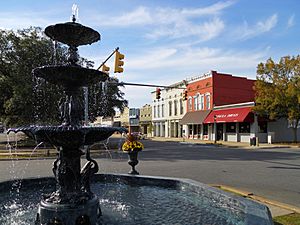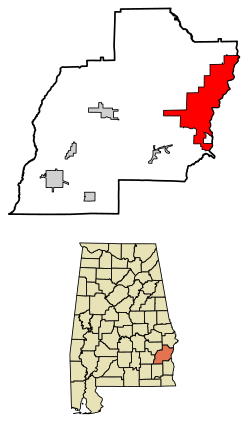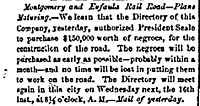Eufaula, Alabama facts for kids
Quick facts for kids
Eufaula, Alabama
|
||
|---|---|---|

The MacMonnies Fountain in downtown Eufaula
|
||
|
||

Location of Eufaula in Barbour County, Alabama
|
||
| Country | United States | |
| State | Alabama | |
| County | Barbour | |
| Named for | Eufaulas | |
| Area | ||
| • Total | 73.47 sq mi (190.30 km2) | |
| • Land | 59.52 sq mi (154.14 km2) | |
| • Water | 13.96 sq mi (36.16 km2) | |
| Elevation | 262 ft (80 m) | |
| Population
(2020)
|
||
| • Total | 12,882 | |
| • Density | 216.45/sq mi (83.57/km2) | |
| Time zone | UTC-6 (Central (CST)) | |
| • Summer (DST) | UTC-5 (CDT) | |
| ZIP code |
36027, 36072
|
|
| Area code(s) | 334 | |
| FIPS code | 01-24568 | |
| GNIS feature ID | 0118051 | |
Eufaula is the largest city in Barbour County, Alabama, United States. In 2010, about 13,137 people lived there.
Contents
History of Eufaula
The area where Eufaula is now was once home to three Creek Native American tribes, including the Eufaulas. By the 1820s, this land was part of Creek territory. White settlers were not supposed to live there.
However, many white settlers moved in illegally. In 1827, the Creeks asked the government for help. Federal troops were sent to remove the settlers. This conflict was called the "Intruders War."
The Creeks signed the Treaty of Washington in 1826. This treaty gave much of their land in Georgia and Alabama to the United States. Later, the 1832 Treaty of Cusseta allowed white settlers to legally buy land from the Creek people. This treaty did not force Native Americans to move.
By 1835, white settlers had bought most of the land where the town now stands. A store was built, partly owned by William Irwin. The new settlement was named "Irwinton" after him.
By the mid-1830s, downtown Irwinton was planned out and growing. Much of its old charm has been saved and is now called the Seth Lore and Irwinton Historic District. In 1842 or 1843, Irwinton was renamed "Eufaula." This was likely to avoid confusion with Irwinton, Georgia, when mail was sent. The town officially became a city in 1857.
In the 1850s, Eufaula became a major shipping center. Its location on the Chattahoochee River made it easy to send goods to the Port of Apalachicola and then to big markets like Liverpool and New York City. Plans for the Montgomery and Eufaula Railroad were also underway. This railroad would include a new bridge over the Chattahoochee.
By November 1859, the railroad company decided to buy enslaved people to help build the railroad. Work on the tracks began in January 1860. When the American Civil War was about to start in 1861, railroad work stopped. The workers were moved to build tracks between Montgomery, Alabama, and Pensacola, Florida. This helped move Confederate troops. After the war, work on the railroad started again. In October 1871, the tracks finally reached Eufaula.
Eufaula During the Civil War
Not much is known about Eufaula during the American Civil War. Few records or newspapers from that time still exist. Alabama left the United States on January 11, 1861. Soon after, a military camp was set up in Eufaula. Soldiers were ready to go to Fort Pickens or other places if fighting started.
Six companies of the Confederate States Army (CSA) were formed in Eufaula and Barbour County. One of these was the Eufaula Zouaves. This unit copied the uniforms and fighting style of French light infantry.
The CSA also ran a military hospital in Eufaula during the war. Eufaula's spot on the Chattahoochee River was important for the Confederate navy. At least one ironclad warship was built in the city.
By April 1865, the Union Army had taken over Selma, Alabama. Plans were made to move Alabama's state government to Eufaula if Montgomery fell. Montgomery was captured on April 12. Governor Thomas H. Watts and other state officials went to Eufaula. The New York Daily Tribune called Eufaula "the fugitive seat of Government of Alabama."
On April 29, 1865, Union General Benjamin Grierson reached Clayton, Alabama. News finally reached Eufaula that the war was over. The mayor of Eufaula and some city council members rode to Clayton. They escorted General Grierson into Eufaula. This helped make sure the city came under Federal control peacefully.
By May 1865, reports said that 10,000 Union troops had taken over Eufaula. Right after the occupation, there was a food riot. People tried to take public supplies illegally. By the end of May, Eufaula was calm enough for mail to be delivered safely.
Reconstruction in Eufaula
In August 1865, cotton shipping from Eufaula started to increase again. However, the amount of cotton was much lower than before the war. Ships going to Apalachicola were mostly empty. In November 1865, a new group of Federal soldiers took over from the old ones. Their commander promised citizens they would not be bothered in their legal work.
In March 1867, the United States Congress passed the first of four Reconstruction Acts. This began the Reconstruction Era. Alabama, including Eufaula, was placed under military control. By October 1867, Barbour County had about 5,000 registered voters. About 1,500 were white, and 3,500 were Black.
City elections were held in March 1870. White candidates won most offices. However, two Black candidates, Washington Burke and Melvin Patterson, won positions as aldermen. Election officials said there was fraud and replaced them with white competitors. In the same election, a Republican candidate named Keills won the City Court Judge job.
In 1874, a group called the White League caused the Election Riot of 1874 in Eufaula. At least 7 Black Republicans were killed, and over 70 were hurt. More than 1,000 people were stopped from voting.
Baptist Churches During Reconstruction
Before the Civil War, Black and white Baptists worshipped in the same churches. By 1866, many Black Baptists wanted to form their own churches. In Eufaula, this process went smoothly. Black Baptists asked the mixed church for permission to separate in May 1866. They were allowed to buy an old church building for their new congregation. This group helped form the Eufaula Association, one of the first Black Baptist groups in Alabama.
Civil Rights Era
Eufaula Housing Case
After the U.S. Supreme Court ruled in 1954 that racial segregation in public schools was against the law, schools in Eufaula stayed separated for a while. In 1955, the Eufaula Housing Authority wanted to buy land where many Black families lived. They wanted to build public housing, a park, and expand the white high school. The Black families thought the city's real reason was to keep their children out of the new high school once schools were integrated.
In 1958, civil rights lawyers Fred Gray and Constance Baker Motley filed a lawsuit. They said their clients' rights were being violated. The federal case was dismissed. But Gray appealed to the Alabama Circuit Court. He argued that the new development would only allow white residents, which violated civil rights. Gray also argued that the city's offers for his clients' properties were too low. He managed to win much higher prices for many families.
Voting Rights Act of 1965
After the Voting Rights Act of 1965 was passed, the United States Department of Justice sent federal observers to 24 southern counties. They made sure people could register to vote. Many counties saw a big increase in Black voter registration. But Eufaula did not have federal supervision, so its rates were lower. For example, on August 16, 1965, 600 Black citizens waited to register in Eufaula. But only 265 were able to complete the paperwork before the office closed.
In 1966, the Student Nonviolent Coordinating Committee (SNCC) sent Daddy Bone to Eufaula. He organized voter registration drives. Bone started peaceful protests and boycotts of local stores that would not hire Black people. This brought SNCC supporters from all over the Southeast. The city of Eufaula passed laws against picketing and arrested many protesters.
School Integration
In July 1968, the United States Department of Justice sued 76 Alabama school districts, including Eufaula. They wanted the schools to follow the Brown v. Board of Education ruling.
Schools in Eufaula remained separated by race until about 1970. After integration began, the school stopped having social events like proms. However, unofficial separate events were still held. By 1990, students at Eufaula High School pushed school officials to allow integrated proms. The first integrated prom was held in 1991 without any problems.
Other Recent History
In 1963, the U.S. Army Corps of Engineers created Walter F. George Lake (also called Lake Eufaula). This lake is behind the lock and dam of Fort Gaines, Georgia. It made Eufaula important again as an inland port.
In the early 1960s, the United States Coast Guard set up a team in Eufaula. This team still helps with navigation from Columbus, Georgia, to Apalachicola, Florida, and the Flint River.
In 1964, the Eufaula National Wildlife Refuge was created along Lake Walter F. George. It protects many rare and endangered animals. These include the American bald eagle, the American alligator, the wood stork, and the peregrine falcon. The refuge is a popular place for visitors.
Geography and Climate
Eufaula is located at 31°53'21.732" North, 85°9'13.586" West. It is on the Georgia state line in southeast Alabama. The city is next to Georgetown, Georgia, which is across the Chattahoochee River. Eufaula is about 75 miles (121 km) southeast of Montgomery, Alabama. It is also 40 miles (64 km) southwest of Columbus, Georgia, and 48 miles (77 km) northeast of Dothan, Alabama.
The city covers about 73.5 square miles (190.3 km2). About 59.4 square miles (153.8 km2) is land, and 14.1 square miles (36.5 km2) is water. Eufaula sits on a reservoir called Walter F. George Lake, or Lake Eufaula to local people.
The climate in Eufaula has hot, humid summers. Winters are usually mild to cool. Eufaula has a humid subtropical climate.
Population Information
| Historical population | |||
|---|---|---|---|
| Census | Pop. | %± | |
| 1850 | 3,000 | — | |
| 1870 | 3,185 | — | |
| 1880 | 3,836 | 20.4% | |
| 1890 | 4,394 | 14.5% | |
| 1900 | 4,532 | 3.1% | |
| 1910 | 4,259 | −6.0% | |
| 1920 | 4,939 | 16.0% | |
| 1930 | 5,208 | 5.4% | |
| 1940 | 6,269 | 20.4% | |
| 1950 | 6,906 | 10.2% | |
| 1960 | 8,357 | 21.0% | |
| 1970 | 9,102 | 8.9% | |
| 1980 | 12,097 | 32.9% | |
| 1990 | 13,220 | 9.3% | |
| 2000 | 13,908 | 5.2% | |
| 2010 | 13,137 | −5.5% | |
| 2020 | 12,882 | −1.9% | |
| U.S. Decennial Census | |||
2020 Census Data
| Race | Num. | Perc. |
|---|---|---|
| White (non-Hispanic) | 5,637 | 43.76% |
| Black or African American (non-Hispanic) | 6,041 | 46.89% |
| Native American | 21 | 0.16% |
| Asian | 64 | 0.5% |
| Other/Mixed | 357 | 2.77% |
| Hispanic or Latino | 762 | 5.92% |
In 2020, there were 12,882 people living in Eufaula. There were 4,969 households and 3,215 families.
2010 Census Data
In 2010, Eufaula had 13,137 people. There were 5,237 households and 3,630 families. The city had 5,829 housing units. The population was 51.0% White, 44.6% Black or African American, 0.5% Native American, and 0.6% Asian. About 4.3% of the people were Hispanic or Latino.
About 30.2% of households had children under 18. The average household had 2.48 people. The average family had 3.01 people.
The median age in the city was 38.9 years. About 26.1% of the population was under 18. About 15.6% were 65 or older.
Education in Eufaula
Eufaula City Schools serves the area. It has two elementary schools and a middle school called Admiral Moorer Middle School. This school is named after Admiral Thomas Hinman Moorer. The local high school is Eufaula High School, and its mascot is a tiger.
Eufaula also has a private school called Lakeside School. Their sports teams are known as the Chiefs. There is also a smaller school called Parkview Christian School. Eufaula was once home to the Eufaula Female Academy, a school for girls founded in 1844.
Culture and Fun
Historic Buildings
Many old buildings in Eufaula are listed on the National Register of Historic Places. Other historic buildings include the Eufaula First United Methodist Church and the First Baptist Church of Eufaula. The Seth Lore and Irwinton Historic District has 667 important buildings. It is the second-largest historic district in Alabama.
The Shorter Mansion was built in 1884. It is recognized by the National Trust for Historic Preservation. The first floor often hosts events. The second floor is a museum honoring the six Alabama governors from Barbour County. It also honors Admiral Thomas Moorer.
The Holleman-Foy House is also on the National Register of Historic Places. It was designed by George Franklin Barber and built in 1907.
Fendall Hall, built from 1856 to 1860, is an Italianate-style historic house museum. The Alabama Historical Commission owns and runs it.
Sports
Lake Eufaula is known as the "Big Bass Capital of the World." This means it's a great place for fishing, especially for bass!
Eufaula also had a minor league baseball team called the Eufaula Millers in 1952 and 1953.
Movie Location
In the 2002 movie Sweet Home Alabama, the old homes shown in Melanie's (Reese Witherspoon) hometown were filmed in Eufaula.
Tree That Owns Itself
The Tree That Owns Itself is an oak tree in Eufaula. It has been replaced a few times. In 1936, the governor gave the tree ownership of its land. Each new tree that replaced it also received ownership of the land.
Notable People
- Alpheus Baker, a general in the Confederate States Army
- Peyton Brown, model and Miss Alabama USA 2016
- Daryon Brutley, former professional football player
- Edward Bullock, Confederate officer and Alabama state senator
- Frank Clark, former member of the U.S. House of Representatives
- James S. Clark, speaker of the Alabama House of Representatives
- S. Hubert Dent Jr., U.S. representative
- Lula Mae Hardaway, mother of entertainer Stevie Wonder
- William Henry Harrison Hart, African American attorney
- Bertha "B" Holt, representative in the North Carolina General Assembly
- Jerrel Jernigan, professional football player
- Walter Kehoe, U.S. representative from Florida
- Reuben Kolb, Alabama politician
- Charles S. McDowell, former lieutenant governor of Alabama
- Thomas Hinman Moorer, chief of Naval Operations and chairman of the Joint Chiefs of Staff
- Martha Reeves, Motown singer
- Walter Reeves, professional football player
- Simon F. Rothschild, merchant
- Eli Sims Shorter, U.S. representative
- John Gill Shorter, 17th governor of Alabama
- Les Snead, general manager of the NFL Los Angeles Rams
- Courtney Upshaw, professional football player
- George Wallace Jr., former Alabama public service commissioner and state treasurer
- Dave Watson, former professional football player
- Edwin "Pa" Watson, U.S. Army major general and aide to President Franklin D. Roosevelt
- Xavier Woodson-Luster, professional football player
- Hunter Wyatt-Brown, former bishop
Images for kids
-
The Walter F. George lock and dam, which creates Lake Eufaula.
-
The Eufaula Carnegie Library, built in 1904.
-
This statue honors men from Eufaula who died in World War I. It was put up in 1920.
Literature
- Alsobrook, David Ernest. Southside: Eufaula's Cotton Mill Village and its People, 1890-1945. Mercer University Press.
See also
 In Spanish: Eufaula (Alabama) para niños
In Spanish: Eufaula (Alabama) para niños
























